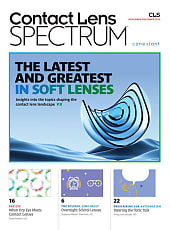The emergence of novel spectacle lenses for myopia control, such as Defocus Incorporated Multiple Segments (DIMS), Highly Aspherical Lenslet (HAL), Correction and Ring-like Elements (CARE), and Diffusion Optics Technology (DOT) designs, has expanded the options available for myopia management overseas. While these spectacle lenses are not yet approved by the U.S. Food and Drug Administration, it’s likely a nod from the U.S. government organization is not too far off. As a result, discussing the factors that influence treatment success makes sense.
Here, I discuss these factors.
Baseline Myopia Progression Rate
Patients whose myopia progresses fast (>-0.50D/6m) tend to show greater benefit from optical interventions.1
Age of Initiation
Younger children (ages 6 to 8) typically experience stronger myopia control effects than older children.1 However, myopia control’s inherent association with the rate of progression makes it difficult to separate which factor plays the dominant role.
Combination Interventions
There is a potential synergistic effect of novel spectacles combined with dual (multi-)focus soft contact lenses (MFSCL), orthokeratology, or low-dose atropine (0.01% to 0.05%)2. That said, these results need to be confirmed by large-scale studies.

Patient Compliance
Real-world usage vs. usage in clinical trials may be inconsistent, reducing overall efficacy and increasing individual variability. Specifically, research suggests that optimal results require at least 12 to 14 hours of daily wear, which many children may not achieve in everyday settings.
Something else to keep in mind: Some patients experience ghosting, glare, or contrast sensitivity reduction due to the lenslet structure of novel spectacle lenses. These effects are usually mild but can lead to discontinuation or poor compliance.
Environmental Factors
Reduced screen time and increased outdoor activity may complement the effectiveness of myopia control lenses. In fact, increased outdoor exposure has an independent myopia-protective effect,
Proper Frame Fitting
Due to the specialty designs of the novel spectacle lenses (ie, a relatively small central single vision area for distance correction surrounded by lenslets in various shape, size, and distribution patterns), the proper fitting of the frame is critical to ensure sufficient “myopia-stop” signals imposed to the retina.
Now You Know.
Novel spectacle lenses represent an important addition to myopia control strategies, offering a non-invasive and widely accessible option for reducing progression. In knowing the factors that influence treatment success, U.S. optometrists are in an excellent position to help these patients when these spectacle lenses become available stateside. Two caveats: ODs should keep an eye out for research on long-term safety testing, and the impact of these lenses on sports performance and motion perception before prescribing. OM
References
1. Yuval C, Otzem C, Laura BS, et al. Evaluating the Effect of a Myopia Control Spectacle Lens Among Children in Israel: 12-Month Results [published correction appears in Am J Ophthalmol. 2024 Mar;259:197. doi: 10.1016/j.ajo.2023.12.015.]. Am J Ophthalmol. 2024;257:103-112. doi:10.1016/j.ajo.2023.08.019.
2. Yang Y, Xiao Z, Ouyang J, Guo Y. Synergistic efficacy of orthokeratology and 0.01% atropine in controlling pediatric myopia progression: A retrospective analysis. Journal of Investigative Medicine. 2025;73(3):290-299. doi:10.1177/10815589241308819.




